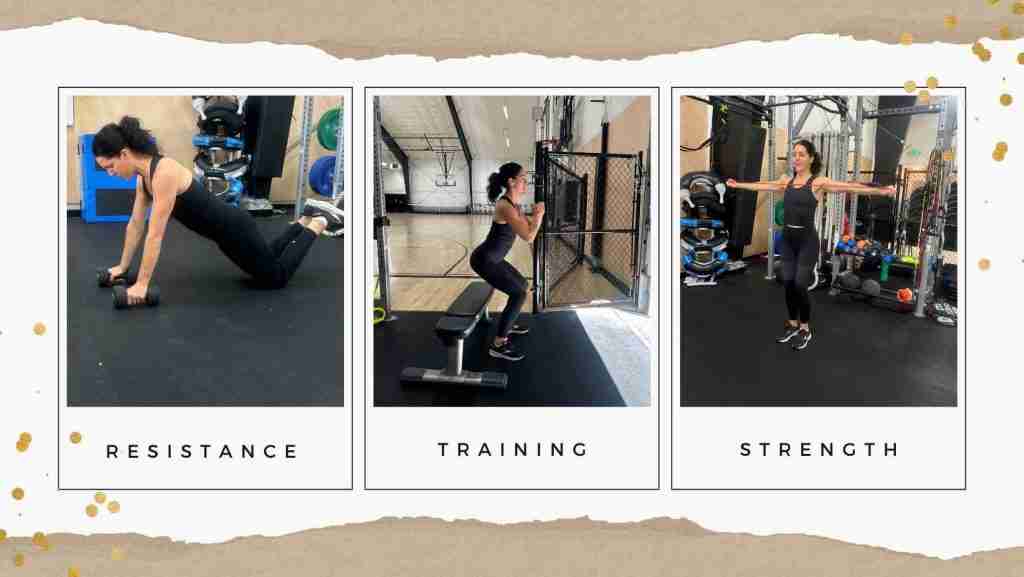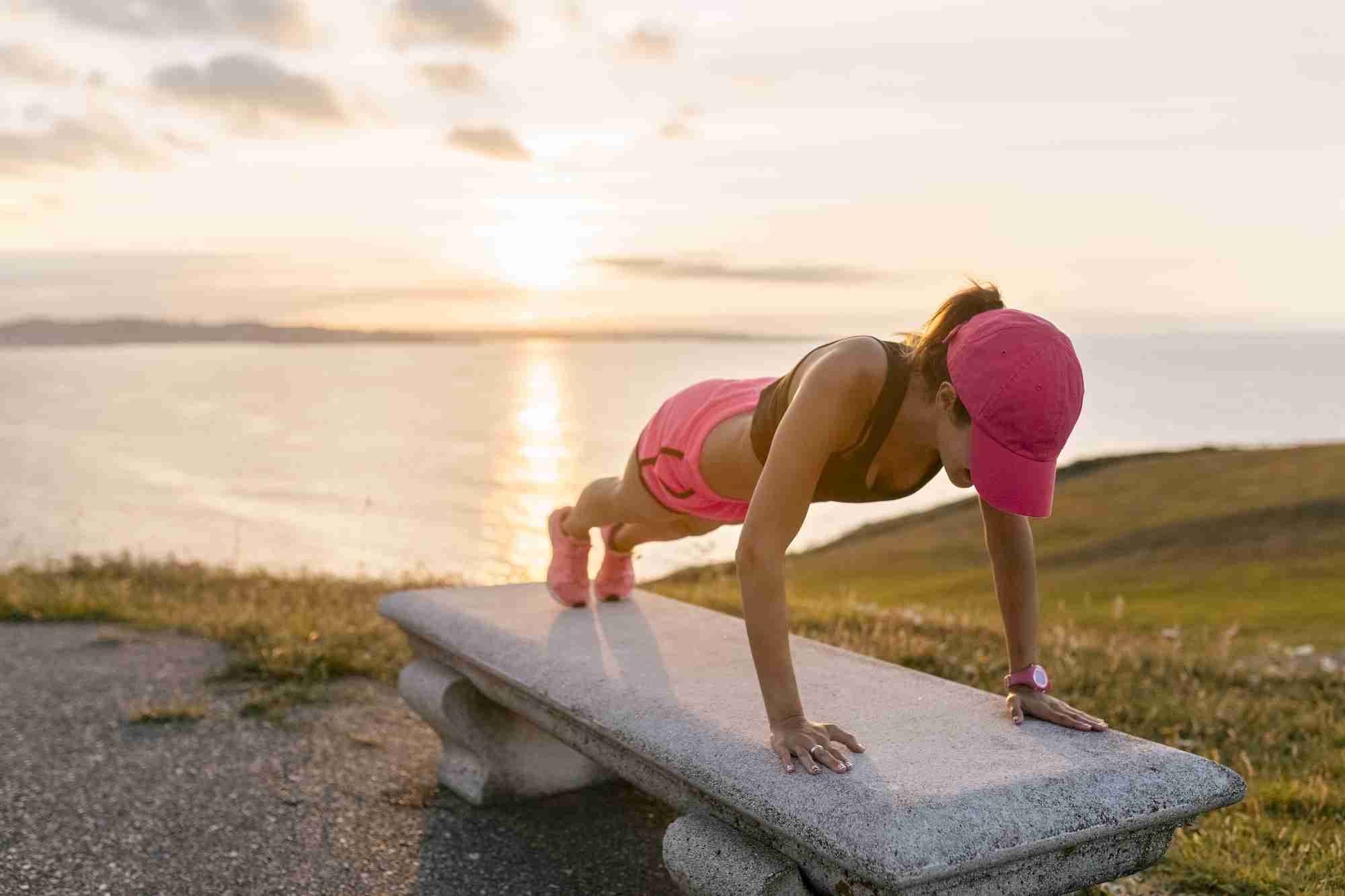17 science-based benefits of strength training for longevity
Can resistance and strength training keep us young and help us live a longer healthier life? New research suggests that it indeed can. The researchers discovered a significant connection between regular resistance training, weightlifting and general strength training and a reduced risk of mortality and the opportunity to slow and even reverse the aging process.
Based on a recent meta-analysis that pooled findings from 16 studies involving over 1.5 million participants, engaging in activities that enhance muscle strength was linked to a nearly 20 percent decrease in the risk of conditions like cardiovascular disease, cancer, diabetes, lung disorders, and overall mortality. I know right?
We will give you the long list of reasons why you should practice routine resistance training. So how does strength training keep us young? See below.

The 17 ways Resistance & Strength Training Keep Us Young
The following are the reasons you may want to consider incorporating resistance training into your weekly routine to slow down the aging process and to feel healthier. Some of the reasons may surprise you.
1. Genes Linked To Age And Exercise
Out of the 596 genes examined, researchers pinpointed 179 genes linked to both age and exercise. These genes exhibited a significant reversal in their expression patterns following six months of resistance training. Some o
This groundbreaking discovery signifies that resistance training possesses the ability not only to decelerate but also to actually reverse the aging process on a genetic level. The gene expression of older individuals became comparable to that of their younger counterparts. Furthermore, the researchers observed a reversal in mitochondrial dysfunction, a condition closely linked to physical inactivity, after six months of training.

2. Helps Fix Damage In Our Cells
By actively engaging in strength training exercises, individuals can effectively slow down and even reverse the age-related loss of muscle mass. This reversal is particularly significant at the cellular level, where the rejuvenation of muscle fibers and the activation of muscle-building processes occur.
More research shows that resistance training can help fix damage in our cells’ powerhouses, called mitochondria, as we get older. An interesting discovery is that doing exercises with resistance, like weights, can actually turn back some aging-related genes in our bodies.
This means that resistance training might make our genes related to getting older work better. This is especially true for genes connected to how our mitochondria work, which is important for energy (Melov et al., 2007).
3. Regulates Blood Sugar
Engaging in strength training enhances the body’s ability to react to insulin, resulting in improved regulation of blood sugar levels following meals. This, in turn, translates to a lowered susceptibility to diabetes or insulin resistance.
Helps Cognitive FunctionStrength training appears to have positive effects on brain health and function, perhaps decreasing the risk of dementia and Alzheimer’s disease, experts say.
Regular physical exercise, especially resistance training, can delay the onset of Alzheimer’s disease.Using a mice model, the team demonstrated a reduction in Alzheimer’s indicators, like beta-amyloid plaques, and normalized stress hormone levels, following resistance exercise training.
4. Preserving Muscle Mass
As we age, our bodies naturally lose muscle mass, which can lead to weakness and frailty. Resistance training and weightlifting help counteract this muscle loss by stimulating muscle growth and maintenance. This enhanced muscle mass contributes to better mobility, balance, and overall physical function, allowing individuals to maintain an active lifestyle as they grow older.
5. Strengthening Bones
Resistance training, also known as strength training, can have a positive impact on bone health through a process called “mechanical loading.” Here’s how resistance training strengthens bones:
Bones are living tissues that undergo a continuous process called remodeling. This involves the removal of old bone tissue (resorption) and the formation of new bone tissue (ossification). Resistance training provides mechanical stress to the bones, which triggers this remodeling process.
Bones, like muscles, respond to the stress placed on them. When you perform resistance exercises that involve lifting weights or applying force against resistance, bones adapt by becoming denser and stronger to better withstand the load.

Prevention of Bone Loss
Resistance training is particularly important as people age. As we get older, bone density tends to decrease, leading to conditions like osteoporosis. Engaging in regular resistance training can help mitigate bone loss and reduce the risk of fractures.
6. Metabolism Boost
Engaging in resistance training and weightlifting increases muscle tissue, which is metabolically active. This means that even at rest, individuals with more muscle burn more calories than those with less muscle. A higher metabolic rate can contribute to maintaining a healthy body weight and preventing age-related weight gain.
7. Enhancing Joint Health
Properly executed resistance training can improve joint stability and function. Strengthening the muscles around joints provides better support and protection, reducing the risk of injuries and joint-related issues commonly associated with aging.
8. Managing Chronic Conditions
Resistance training has been shown to positively impact various chronic health conditions often associated with aging, such as type 2 diabetes, cardiovascular disease, and arthritis. By improving muscle strength and metabolic health, resistance training can help manage these conditions and improve the overall quality of life.
9. Neurological Benefits
Engaging in resistance training promotes the release of neurotrophic factors, which support the health and function of nerve cells. This can have a positive impact on cognitive function and reduce the risk of cognitive decline and neurodegenerative diseases.
10. Hormonal Balance
Resistance training can lead to the release of hormones such as testosterone and growth hormone, which play essential roles in maintaining muscle mass, bone density, and overall vitality. These hormonal responses contribute to healthy aging.
11. Psychological Well-being
Engaging in resistance training triggers the release of endorphins, which are natural “feel-good” chemicals in the brain. These endorphins act as stress reducers and mood enhancers, helping to alleviate feelings of anxiety and stress.
Regular resistance training has been shown to improve mood and reduce symptoms of depression. The increased release of endorphins and other neurotransmitters, such as serotonin, can create a sense of well-being and happiness.
Physical activity, including resistance training, has been linked to cognitive improvements. It can enhance cognitive function, memory, and concentration, which can contribute to a clearer and more focused mind.
12. Increases Metabolism
Building muscle and reducing body fat, is like giving your body an internal boost for its metabolism and weight management. When you work on building muscle through activities like strength training, your body needs more energy to fuel those muscles.
This means your metabolism gets a kick, and it starts burning more calories even when you’re not exercising. With that said, you can’t make up for a bad diet with exercise.
Building muscle and reducing body fat, is like giving your body an internal boost for its metabolism and weight management. When you work on building muscle through activities like strength training, your body needs more energy to fuel those muscles.
This means your metabolism gets a kick, and it starts burning more calories even when you’re not exercising. With that said, you can’t make up for a bad diet with exercise.

13. Heart Health
When you engage in resistance training, like lifting weights or using resistance bands, you’re giving your heart a workout, too.During resistance exercises, your heart has to work a bit harder to pump blood to your muscles. This extra effort strengthens your heart over time, making it more efficient at pumping blood throughout your body.
As your heart becomes stronger, it can handle everyday tasks with greater ease, and your overall cardiovascular health improves.Additionally, resistance training has been shown to lower certain risk factors for heart disease.
It can help reduce bad cholesterol (LDL cholesterol) levels and increase good cholesterol (HDL cholesterol) levels. It also helps manage blood pressure by improving blood vessel function and reducing the workload on your heart.
14. Hormonal Balance
Regular exercise and muscle recovery help regulate hormones, such as growth hormone and testosterone, that play a role in maintaining youthfulness and vitality. These hormones contribute to muscle growth, bone density, and overall energy levels.
15. Mitochondrial Health
Exercise and recovery also support the health of mitochondria, the energy powerhouses of your cells. Mitochondrial function declines with age, but consistent physical activity helps maintain their efficiency, providing energy for bodily functions and slowing down the aging process.

16. Collagen Production
The process of muscle recovery also stimulates collagen production. Collagen is essential for maintaining the elasticity of your skin and connective tissues, contributing to a youthful appearance.
17. Posture Improvement
Throughout the years, I have come to appreciate and fully understand the importance of resistance training in proper form. Regular strength training not only prevents the effects of a sedentary lifestyle but also preserves bone mass and boosts longevity.
I am strengthening my body against the challenges that time presents with each mindful repetition. – You know what’s even more impressive? How the range of motion in weightlifting will protect you from falling as you get older.
Lifting weights has helped me regain strength, resilience, and an unwavering zest for life as I age – a testament to their transformative power.

The Average American Adult Does Not Engage In Sufficient Resistance Training
The problem is that a large portion of older Americans do not engage in sufficient physical activity, including resistance training, to maintain or improve muscle mass. In the U.S., for example, only about 25% of adults aged 65-74 meet the recommended guidelines for muscle-strengthening activities. Generally, women tend to experience a more rapid decline than men.
The American College of Sports Medicine (ACSM) recommends healthy adults should perform a strength training program at least twice a week with one set of 8 to 12 repetitions.

“Older adults who engaged in weightlifting exercises demonstrated notably lower mortality rates even when accounting for participation in aerobic exercises. Remarkably, those who combined both forms of exercise exhibited the lowest risk.” – Jessica Gorzelitz, PhD, National Cancer Institute.
The good news is that resistance training doesn’t have to be hard. It’s actually quite simple and adaptable. You can start at your own pace and gradually increase. By focusing on doing exercises correctly and choosing ones you like, you can make resistance training fit into your routine. So, don’t worry about it being tough – resistance training is a flexible way to get stronger and healthier.

The Science Behind Longevity and Resistance Training
Scientific research consistently highlights the pivotal role of resistance training in promoting health and well-being as we age. As we grow older, muscle mass naturally declines, which can lead to reduced strength, mobility, and increased risk of chronic conditions. However, numerous studies have demonstrated that regular resistance training can effectively counteract these effects.
A comprehensive review published in the “American Journal of Lifestyle Medicine” emphasizes that resistance training can significantly increase muscle mass and strength, enhancing overall functional capacity and quality of life among older adults.
Another study featured in the “Journal of Aging and Physical Activity” highlights that consistent resistance training not only improves muscular strength but also positively influences bone density, reducing the risk of osteoporosis and fractures.
Moreover, research from the “British Journal of Sports Medicine” underlines how resistance training contributes to metabolic health by enhancing insulin sensitivity and glucose regulation, thus mitigating the risk of type 2 diabetes. Additionally, a study in the “Journal of the American Geriatrics Society” suggests that resistance training plays a pivotal role in reducing the likelihood of falls, a critical concern among the elderly population.
Daniel J. McDonough, a researcher affiliated with the University of Minnesota’s School of Public Health and a co-author of an extensive study investigating the impact of both aerobic and muscle-strengthening exercises on mortality, commented, “Strength training brings about a range of health advantages that stand apart from aerobic exercises.” Additionally, he highlighted that incorporating some muscle-building activities also enhances physical fitness, bone mineral density, and lessens the likelihood of musculoskeletal injuries.

When You Engage Your Muscles You Slow Down Age-Related Muscle Loss
The significance of preventing muscle mass loss goes beyond just physical appearance; it plays a vital role in maintaining overall health and youthfulness. Muscles serve as not only the body’s mechanical powerhouses but also as metabolic hubs. They contribute to the efficient burning of calories and the regulation of various metabolic processes.
Furthermore, muscles have a profound impact on bone health and joint stability. A decline in muscle mass can lead to increased susceptibility to fractures and injuries, which are common indicators of aging. By preserving muscle mass through strength training, individuals can safeguard their bones and joints, promoting long-term mobility and vitality.
There are seventeen easy strength training exercises for longevity, see them here.
Vital Muscles Enhances Physical Capabilities
In essence, strength training is a potent tool that directly counteracts the cellular processes associated with aging, primarily by preventing the loss of muscle mass. This preservation of muscle tissue translates into enhanced physical capabilities, improved metabolism, better bone health, and ultimately, a more youthful and vibrant quality of life.
Who wants to have muscle weakness and a higher risk of falls later on in life? Not me! The stronger we are the more stable we are.
Incorporating resistance training and weightlifting into your routine, even in moderation, can have a profound impact on promoting a longer, healthier, and more active life as you age. It’s important to consult with a healthcare professional before starting any new exercise regimen, especially if you have preexisting health conditions or concerns.
Understanding Muscle Strength as We Age
Dr. Roger A. Fielding, a scientist supported by NIA and based at Tufts University, believes in the importance of keeping our muscles strong as we grow older. He conducts studies to learn more about how our muscles change with age and how resistance training can help prevent frailty and improve our ability to move and be independent.
Dr. Fielding’s research looked at different exercises for older adults with mobility issues. He explains that to grasp why muscles matter, we need to know what happens inside our bodies when we exercise. We Need To Make Our Muscles Contract Against Resistance
Strength training, which is different from activities like running or walking, makes our muscles contract against resistance. This can be lifting weights, using resistance bands, or doing exercises like pushups or boxing.
When we do this, our bodies use up a molecule called ATP for energy, and this triggers various changes in our muscles, making them better at handling energy from sugar and fat.
Dr. Fielding found that the best way to stay active and avoid problems as we age is a mix of walking and resistance training. Older adults in his studies exercise together in groups, guided by a fitness trainer. They use different weights or their own body weight for exercises.

When we do strength training, it affects molecules that send signals between our cells, leading to positive changes that last even after we’re done. Even light strength training and walking have great benefits.
The group sessions also help participants bond and support each other, keeping everyone motivated.
Dr. Fielding doesn’t just study this–he practices it. He includes strength training in his routine to stay strong and continue doing things he enjoys, like skiing.
Muscle mass naturally decreases with age. On average, people can lose about 3-8% of their muscle mass per decade after the age of 30. Muscle strength also declines as people age. After the age of 30, there’s a decrease in strength of about 1-2% per year.
Here Are Examples Of Resistance and Strength Training:
Resistance and strength training encompass various exercises and activities that aim to increase muscular strength and endurance by working against resistance. Here are some common forms of resistance and strength training:
- Weightlifting: This involves using free weights, such as dumbbells and barbells, or weight machines to target specific muscle groups. Exercises include bench presses, squats, deadlifts, and bicep curls.
- Bodyweight Exercises: These exercises use your body weight as resistance. Examples include push-ups, pull-ups, squats, lunges, and planks.
- Resistance Bands: Elastic bands provide resistance throughout the range of motion. They can be used for various exercises, such as bicep curls, lateral raises, and leg lifts.
- Cable Machines: These machines use a cable and pulley system to provide resistance. They allow for a wide range of exercises that target different muscle groups.
- Kettlebell Training: Kettlebells are weighted, cast-iron balls with handles. Kettlebell exercises like swings, snatches, and Turkish get-ups improve strength, flexibility, and coordination.
- Calisthenics: This form of training involves using your body weight for resistance and includes exercises like push-ups, squats, burpees, and handstands.
- Resistance Training Classes: Many fitness classes incorporate resistance training, using a combination of weights, resistance bands, and bodyweight exercises to improve strength and endurance. This includes using your own body weight like yoga.
- Pilates: While emphasizing core strength, Pilates involves controlled movements that improve flexibility, balance, and muscular endurance.
- CrossFit: CrossFit combines various forms of resistance and cardiovascular training to create high-intensity workouts that target overall fitness and strength.
- Functional Training: This type of training mimics real-life movements and tasks to improve overall strength, balance, and coordination. It often involves exercises that engage multiple muscle groups simultaneously.
- TRX Training: Using a suspension trainer, TRX exercises leverage body weight to engage multiple muscles and improve core strength and stability.
- Strongman Training: This specialized form of training involves lifting and moving heavy objects like tires, logs, and Atlas stones to build functional strength.
Remember that the most effective training programs often incorporate a variety of these forms to target different muscle groups and achieve well-rounded strength and fitness. It’s important to consult with a fitness professional before starting a new training regimen to ensure that the exercises are suitable for your individual goals and physical condition.
Most Frequently Asked Questions About Resistance and Strength Training: Q: How many repetitions and sets should I do?
A. It depends on your goals. For strength, aim for lower repetitions (around 4-6) with heavier weights. For endurance, go for higher repetitions (around 12-15) with lighter weights.Q. How much weight should I lift?
A. Start with a weight that you can lift comfortably for the prescribed number of repetitions while still challenging yourself. Gradually increase weight as you get stronger.Q. How long does it take to see results from strength training?
A. Initial strength gains can be seen in a few weeks, but noticeable changes typically take a few months of consistent training.Q. Should I do cardio alongside strength training?
A. Cardio and strength training can complement each other. Including both can provide well-rounded fitness benefits.Q. Can strength training help with fat loss?
A. Yes, strength training can increase your metabolism and help you burn more calories, contributing to fat loss when combined with a balanced diet.Q. Will lifting weights make me bulky?
A. Gaining significant muscle mass (bulking up) requires specific training, diet, and often, genetic predisposition. Regular strength training alone won’t necessarily lead to excessive bulkiness for most people.Q. What’s the difference between free weights and machines?
A. Free weights (dumbbells, barbells) engage stabilizing muscles more, while machines provide more controlled movements. Both have their place in a well-rounded routine.Q. How do I prevent injuries during strength training?
A. Prioritize proper form, start with lighter weights, progress gradually, warm up before training, and listen to your body. If you’re unsure, consult a fitness professional.







